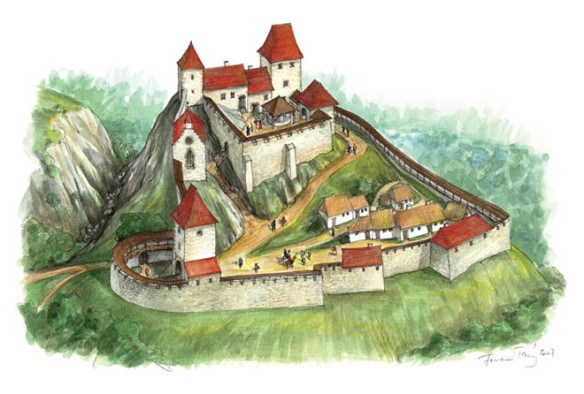Csókakő Castle – an artistic rendering as it looked during the late Middle Ages (Credit: Ferenc Tamas)
Towering above its surroundings, a fortress perched high above a village has a timeless appeal. It is a magnet to the eyes, allowing the imagination to wander back in time to the Middle Ages when chivalry and honor were seemingly all that mattered. It is as though warriors are still perched on the heights above, behind formidable walls, ready to defend to the death their lonely outpost. For the enemy, these same walls would have looked impregnable. They offered an almost insurmountable obstacle, but that was nothing compared to the topography. Sloping, precipitate hillsides were as much a part of an elevated castle as were its stone walls. By the time a besieging army attempted to scale nature’s heights, they would have despaired at the near impossible task of confronting the thick, stone walls ahead and above them.
Located in the Transdanubian region of western Hungary, high above an 1,100 person strong village bearing the same name, the medieval castle of Csókakő has stood the test of time. Its location bears as much responsibility for its security as the stone walls. The castle was constructed several hundred meters above the surrounding landscape on a rocky plateau that is part of the Vertes Mountains. The hillsides were nearly vertical on three sides of the castle’s strategic location. The lone approach was from the western side, but a defensive ditch guarded that direction. Natural geological processes that unfolded over millennia created this piece of highly defensible terrain. It is little wonder that the Hungarian nobility of the Middle Ages chose such a strategic setting to safe guard their existence.
The Ottoman victory at the battle of Mohacs, 1526, not only decided the fate of Hungary but also drastically transformed the battle environment and face of the combat in the western theater. After Mohacs, the Habsburgs, who had replaced the Hungarians as the Ottoman’s principal adversary, launched a large construction campaign of renovating old fortresses and building new ones based on the latest Italian designs. This was congruent with contemporary Western European experiences and pitched battles, and short decisive wars became very rare, whereas long wars of sieges and reliefs became the norm. Süleyman conducted seven large campaigns against Hungary between 1529 and 1566. Although the borders of the empire moved further west, none of the campaigns achieved the decisive victory that would have led to the stability and security the Ottomans required. This inconclusive state of events-in which fortresses changed hands, new ones were built, and the personnel strength of fortress garrisons ever increased – continued to dominate the Ottoman northwestern frontier until the end of the seventeenth century.
Because of the formidable terrain, Csókakő castle was a mighty symbol. Constructed in the late 13th century, it became one of the main political centers for Fejér County, second only to the royal coronation site at nearby Szekesfehervar. The castle was a critical part of a series of fortifications built to guard the road between the cities of Gyor and Komarom. Despite Csókakő castle’s supposedly impregnable location it fell to the Ottoman Turks during the 16th century. This was just the beginning of a chaotic period in the castle’s history. It was the scene of numerous battles over the next 140 odd years as it changed hands multiple times. For instance, in a battle that took place in the autumn of 1601, Hungarian forces under the command of Archduke Matthias emerged victorious. Less than a year later they had lost the castle. It was not until 1687 that the fortress was cleared of all Turkish forces. At this point the region was devoid of population and the castle began an afterlife as a ruin. After resettlement of the area the Austrian Habsburg’s had little interest in rebuilding the castle. They did not want to give any possibly rebellious Hungarian subjects a fortification that one day might be captured and used against them.
The County of Fejér – coat of arms
The coat of arms is a standing, triangular shield with a blue background.
An irregular green hill can be seen at the bottom of the shield and a castle stands on it. It is built of silver bricks. A spired bastion rises on either side of the castle. A drawn-up portcullis opens in the middle of the castle wall. In the middle a red topped tower rises above the castle wall. Two smaller triangular shields are put on the upper part of the shield. A gold bunch of grapes can be seen on the left shield. A gold vine leaf is joined to the bunch of grapes from the right. A gold handled, silver bladed knife can be seen to the left of the bunch of grapes. A silver stylized bird (a daw) can be seen on a gold twig on the left shield.
A stylized castle can be seen on the coat of arms which symbolizes the castle of Csókakő. The castle is divided into an older, upper castle and a later built lower castle in reality. Heraldry prohibits the representation of the space that is why only a civil-living quarters’ tower – which rises above the castle wall – symbolizes the upper castle.
On the right-hand side of the coat of arms the so-called – floating coat of arms – represents a stylized, silver daw. The castle and the village got its name after that daw.
On the right-hand side there is also the another coat of arms agrees with the original seal mark of the village or the rubber-soled seal mark from 1903. All in all it can be said that the coat of arms of Csókakő is a so-called information coat of arms since it tells us the name, the history and the geographical position of Csókakő.
